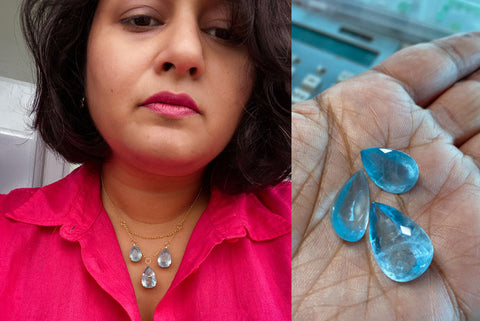Welcoming the month of March, I delve into the beautiful and pristine birthstone for this month- the Aquamarine!
As the name itself suggests, it is not too hard to guess the origin of the name aqua for water and marine as in marina in Latin for the sea. What may be surprising for most people who are new to the world of gemstones is that Aquamarine is a close cousin of the revered Emerald, in fact they belong to the same family- Beryl.

Name: The name of this mineral is derived from Greek ‘Beryllos’ meaning ‘precious blue-green colour-of-sea water stone’, which itself was derived from Indian Prakrit Veruliya which may indicate the town of Velur in Karnataka, India.
Chemistry: Be3Al2(Si6O18) may not sound farther from a precious gemstone, but that is the very chemical composition that makes up the Beryl family- our very own Emeralds and Aquamarines. What sets them apart is their coloring agents in the form of some deposits and impurities and the Aquamarine, mostly gets its greenish blue colour from the presence of Iron.
While traditionally the sea-greenish blue of Aquamarine was preferred, nowadays most samples are heated to remove the yellowish traces that lend greenish tints, and we have pure sky blue stones.

Geology: Aquamarines are mostly found in the form of pegmatites, which are essentially large igneous rocks made up of interlocking crystals made up of different minerals. This type of aquamarine then is basically formed as liquid magma from inside the earth is shot up to the crust and slowly cools down over thousands of years, as certain chemicals come together and form their own kind of gemstones. Aquamarine occurs as hexagonal rods/ prisms.
Deposits, Sources, Cutting : The most famous deposit of Aquamarines is in Minas Garais, Brazil. While mining into the earth is one way to derive the gemstones, the more preferred way is alluvial mining. Along the river Jequitinhonha, gem minerals are segregated by the flowing water, tumbled and smooth deposits are thus found, sieved and obtained. Other than Brazil, Aquamarine is also found in Madagascar, Mozambique, Pakistan, Zambia, Afghanistan and few others. A few deposits are found in India too. As with most gemstones, most aquamarines are cut by skilled artisans in the Indian city of Jaipur where all gemstones travel to get the best out of them!
Famous Aquamarines: A 110kg Aquamarine crystal was found in Mias Gerais in Brazil in 1910 and purchased by a dealer in Idar-Oberstein in Germany. The world’s largest cut Aquamarine is the Dom Pedro, cut as an Obelisk and now at the Natural History Museum in Washington, D.C. The third famous Aquamarine, also sourced from Brazil is the Roosevelt Aquamarine 1,298 carat, the source crystal also yielded a 865ct Aquamarine which was bought by the Maharaja of Kapurthala.

A Gemologist’s selection: The most sought after Aquamrines are absolutely clean, with no inclusions and a sky blue colour. While most jewellers love these, I also have a fondness for milk aquamarines, which are the part of the crystal that is not absolutely clear, rather has some veins and crystals, but make it a more intriguing blue for me personally. Pictured above: The most gorgeous milky blue Aquamarine pear-shaped drops sourced and cut in Jaipur, worn by me below. Be it their watery clear version with the right tinge of blue or the slightly opaque variety, like all gemstones try finding an aquamarine that talks to you and the one that the sea-lover inside you falls in love with!


